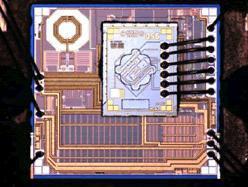With very few exceptions, every electronic circuit needs an oscillator, also referred to as a clock, clock generator, or timing circuit. Its role is to provide the “heartbeat” for the processor, memory functions, communications ports, A/D and D/A converters (if any) and many other functions. In non-critical, low-budget situations such as $10 mass-market electronic thermometers, this clock may be made from a simple resistor/capacitor (RC) oscillator. However, for the vast majority of situations which are more critical, the oscillator is based on a quartz crystal (Figure 1). This is a mature (80+ years) and highly effective technology which can support of wide range of frequencies from kHz to hundreds of MHz, with performance spanning fairly good to excellent, depending
However, crystal advances have reached a plateau, while demands on the timing function’s performance, size, cost, and integration are increasing. To meet these needs, a new and disruptive approach is starting to encroach on quartz devices, based on silicon MEMS (microelectromechanical systems) technology which can provide quartz-level performance, and at a performance and cost level which is suitable for many applications. MEMS devices are already highly developed and used in high volume for sensing pressure, motion, and acceleration, and they are now being extended to a new role.
The demands on the timing function are especially challenging in RF applications, where the oscillator is not just a clock for the processor and where a little jitter is tolerable. In RF, it establishes basic carrier/channel tuning at hundreds of MHz and into the GHz range, to ensure proper clocking of the A/D and D/A converters. For converters, any jitter transforms into converter noise and distortion, and so is a critical specification in RF designs.
Oscillator operation
The structure and operation of a crystal timing device is based on the long-known piezoelectric principle, whereby an electrical signal induces stress in a crystal, and the reverse is true as well: applied stress causes the crystal to generate a minute voltage. By using a tiny slab or blank of quartz along with a suitable circuit, the quartz acts as a tuned resonator to provide precisely-spaced clocking signals for the entire electronic system.
In a MEMS-based device, a radically different approach is used. The etched silicon at the core of the die acts like a tuning fork which resonates at the desired frequency, while additional electronic circuitry on the die manages and amplifies this clock signal
There are dozens of first-, second-, and even third-tier parameters which are used to assess any oscillator, whether crystal or other. The required minimum or maximum values depend on the application, of course, but the relative weighting of these parametric varies with the design.
Key parameters include nominal operating frequency, absolute accuracy, aging-related stability, short- and long-term drift (temperature coefficient and compensation), jitter, operating temperature range, packaging and size, operating voltage, supply sensitivity, power dissipation, shock/vibration resistance, start-up time, vender variations, and cost, to cite a few. Most of these are legitimately measured in different ways and under different conditions, depending on both the application demands as well any historical context.
For more detail: MEMS Oscillators Challenge Quartz Crystals in RF Applications
